Heading out the door? Read this article on the new Outside+ app available now on iOS devices for members! Download the app.
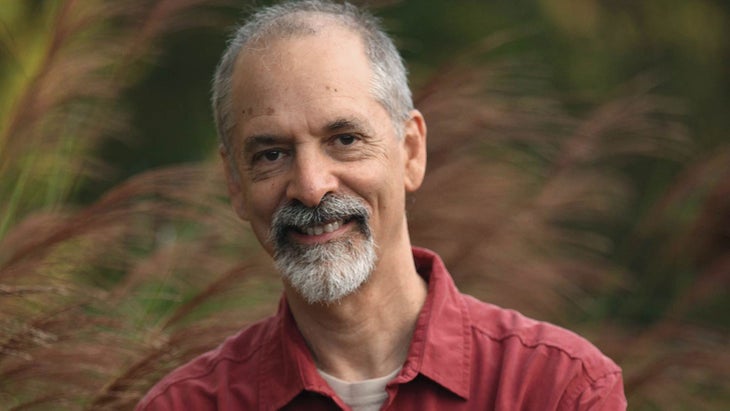
We use the term Viniyoga—an ancient Sanskrit term that implies differentiation, adaptation, and appropriate application—to refer to an approach that adapts yoga practice to the unique conditions, needs, and interests of each individual. This traditional yoga lineage gives each practitioner the tools they need to individualize and actualize the process of self-discovery and personal transformation.
In Viniyoga, we believe that yoga can effect positive change in each practitioner. This requires an understanding of a person’s present condition, personal potential, and goals. Using the teachings and practices of yoga—including asana, pranayama, bandha, sound, chanting, meditation, personal ritual, and the study of texts—we create an integrated practice to help practitioners move through pain, grief, depression, addiction, and more.
See also Meet Gary Kraftsow: A Leading Teacher of Viniyoga Yoga Therapy
There are four main differences between the Viniyoga approach to asana and most other forms of asana practice:
- Function over form. We emphasize the function rather than the form of asana and use the science of adapting the forms of the postures to achieve different results and benefits.
- Breath and adaptation. We focus on breath as the medium for movement in asana, and the science of adapting the pattern of breathing in postures to produce different effects, depending upon the goal.
- Repetition and stay. The use of repetition into and out of the postures, as well as holding the postures, enhances the structural and energetic effects of practice.
- The art and science of sequencing. Viniyoga teachers create practices of different orientation, length, and intensity to suit the intention and context of each practice and practitioner.
According to Krishnamacharya, the grandfather of most Western forms of the practice, a yoga teacher must strive to understand the true needs of the student and to adapt a practice to serve those needs. He reminded teachers emphatically that teaching is for the student, not the teacher. It is through the choices that we make in sequencing that we are able to create usable and relevant yoga practices for specific students.
Patanjali and other great yoga masters recognized the diversity among people and within the same person at different stages of life. They proposed a range of tools, leaving it up to the teacher to decide which were appropriate. Those tools include asana, pranayama, meditation, ritual, chanting or mantra, and prayer.
See also YJ Interview: Gary Kraftsow
A Viniyoga sequence is a logically ordered, context specific strategy that uses the tools of yoga to actualize an intention. It is effective, efficient, and elegant.
In the following sequence for working with addiction, you will notice the integrated use of all of these tools. Addiction impacts us in a multidimensional way, affecting our anatomy and physiology, emotions and cognition, and behavior. As such, an integrated practice that works on all of these levels is the ideal way to create a positive direction of change in our lives.
Find a comfortable, quiet space and be mindful of your breath—a primary focus of Viniyoga—as you work through the following sequence. As Krishnamacharya once said: “If you’re not regulating your breathing, you’re just doing calisthenics.”
Try This Viniyoga Sequence Below:
Visualization

Stay in Savasana. Visualize you are in a forest on a mountain. Sense the smells, feel the breeze, hear the sounds, see the light through the trees.
Imagine, as you are walking, you see a bubbling spring. There’s nothing above it – the water just bubbling up from the earth. See it, smell it.
As you look at the spring, see it as a symbol of the mystery of your birth: the water emerging from the depths and mystery of the earth, as you emerged from your mother’s womb.
See a small stream emerging from the spring. Think of the stream as the earliest memories of your childhood. Walk down the stream and see it widen as you grow in your experience.
Follow the stream down the hill, remembering the as best as you can, the joys as well as the challenges. Remember your first friends and how your self-concept formed as you went to school. Follow the stream until it merges with other streams representing your life in society, past adolescence and into young adulthood, when the stream merges with the river of your life.
See the river get wide and peaceful: think of good memories and successes. Then see the river get fast and narrow, remembering challenging, even dangerous times.
Reflect on the choices you have made as you bring yourself down the river of your life to the present moment. Also reflect on how quickly time has passed. Looking forward, realize that the river is inexorably flowing to the ocean: to the end of life when you will merge back with your source.
See also A Guided Visualization Practice to Open Your Heart
Visualization

Stay in Savasana. Visualize you are in a forest on a mountain. Sense the smells, feel the breeze, hear the sounds, see the light through the trees.
Imagine, as you are walking, you see a bubbling spring. There’s nothing above it – the water just bubbling up from the earth. See it, smell it.
As you look at the spring, see it as a symbol of the mystery of your birth: the water emerging from the depths and mystery of the earth, as you emerged from your mother’s womb.
See a small stream emerging from the spring. Think of the stream as the earliest memories of your childhood. Walk down the stream and see it widen as you grow in your experience.
Follow the stream down the hill, remembering the as best as you can, the joys as well as the challenges. Remember your first friends and how your self-concept formed as you went to school. Follow the stream until it merges with other streams representing your life in society, past adolescence and into young adulthood, when the stream merges with the river of your life.
See the river get wide and peaceful: think of good memories and successes. Then see the river get fast and narrow, remembering challenging, even dangerous times.
Reflect on the choices you have made as you bring yourself down the river of your life to the present moment. Also reflect on how quickly time has passed. Looking forward, realize that the river is inexorably flowing to the ocean: to the end of life when you will merge back with your source.
See also A Guided Visualization Practice to Open Your Heart
Tadaka Mudra
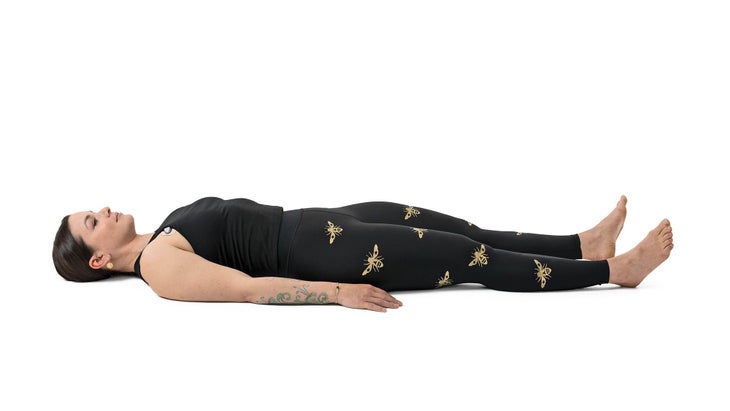
C Exhale as your arm lowers to your side and your foot relaxes. Repeat on the other side. Repeat both sides again, retaining your breath for 3 seconds.
Tadaka Mudra
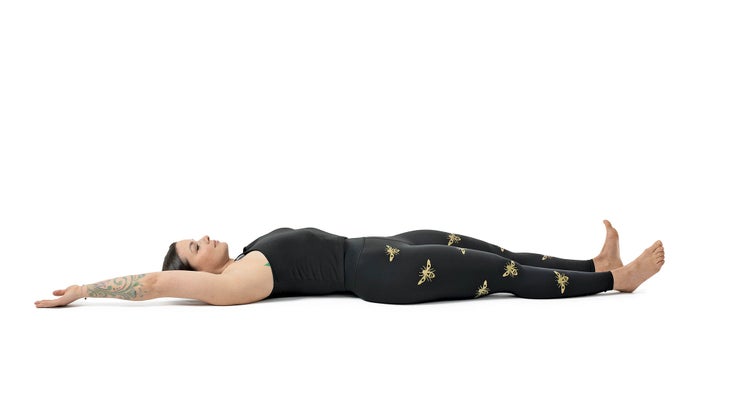
B Inhale your right arm up and over while you flex your left foot. Retain your breath for 2 seconds.
Tadaka Mudra

C Exhale as your arm lowers to your side and your foot relaxes. Repeat on the other side. Repeat both sides again, retaining your breath for 3 seconds.
Tadaka Mudra
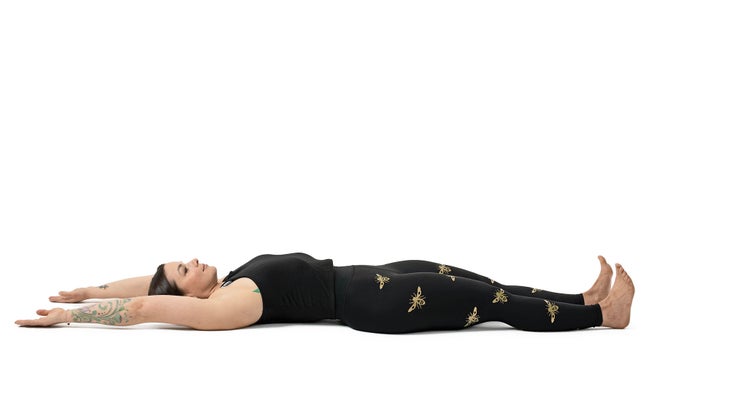
D Then inhale both arms up and over while flexing both feet. Hold the breath for 2 counts. Exhale your arms down to your sides and relax your feet. Inhale your arms back again. Hold for 3 counts. Exhale to lower your arms and relax your feet.
Repeat on the other side, before bringing both arms up.
Dvipada Pitham
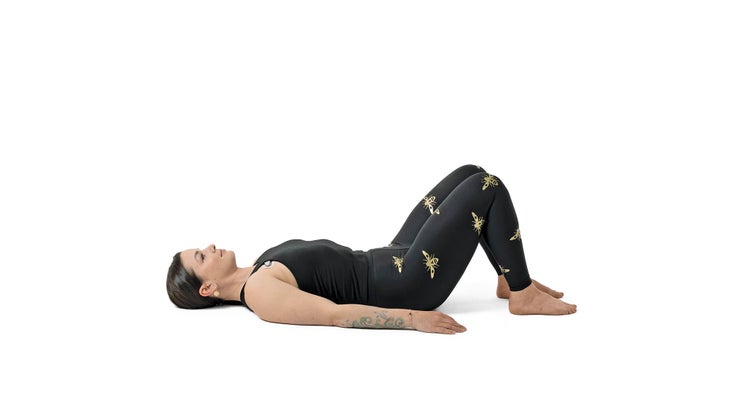
C Exhale and return to start. Repeat on the other side. Repeat both sides again holding your breath for 3 seconds.
Dvipada Pitham
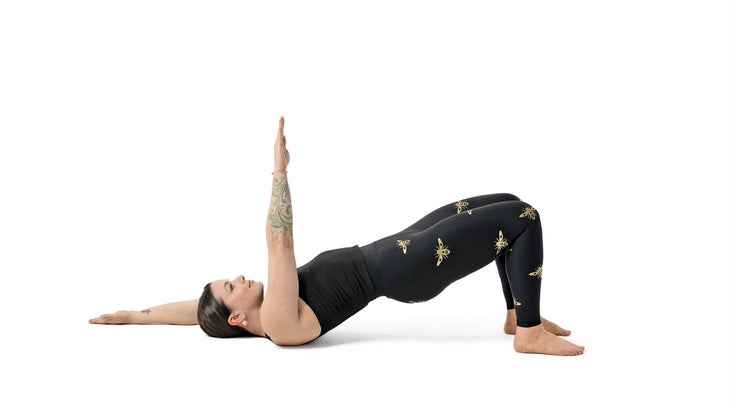
B Inhale as you lift your hips, your right arm up and overhead, and your left arm so that it is pointing at the ceiling. Hold your breath for 2 counts.
Dvipada Pitham

C Exhale and return to start. Repeat on the other side. Repeat both sides again holding your breath for 3 seconds.
Dvipada Pitham
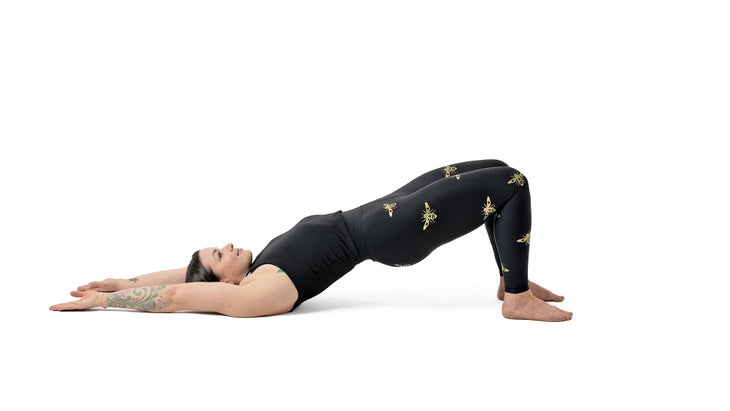
D Then inhale both arms to the floor behind you as you lift your hips. Hold the breath for 2 counts. Exhale back to the starting point. Repeat holding your breath for 3 counts. Exhale to lower.
Repeat on the other side, before bringing both arms up.
Apanasana
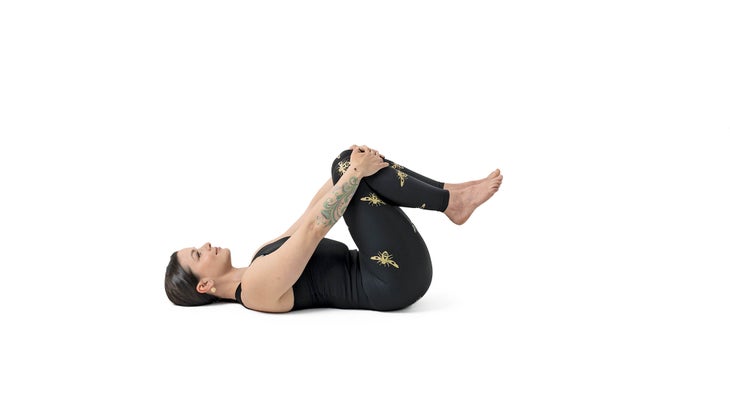
C Inhale as your right knee moves away from your chest. Repeat with your left leg. Repeat again each side, holding your breath for 3 seconds after exhale.
See also 16 Poses to Ease Back Pain
Apanasana
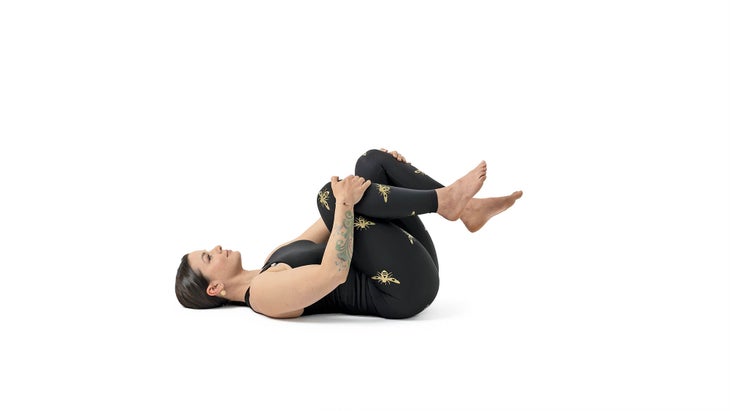
B Exhale, moving your right knee toward your chest. Hold your breath for 2 counts.
Apanasana

C Inhale as your right knee moves away from your chest. Repeat with your left leg. Repeat again each side, holding your breath for 3 seconds after exhale.
See also 16 Poses to Ease Back Pain
Apanasana
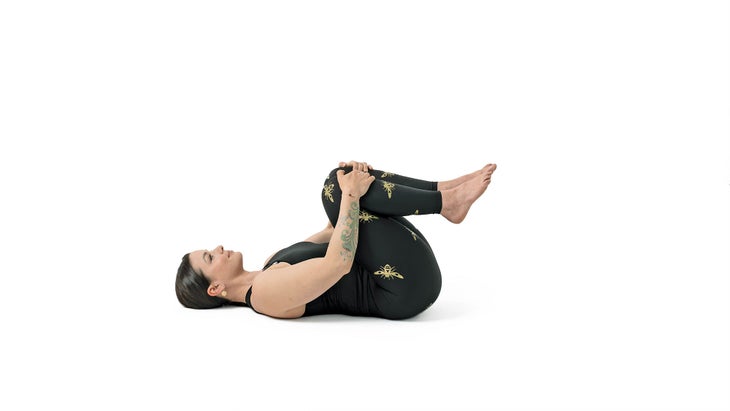
D Exhale, moving both knees toward your chest. Hold your breath for 2 counts. Inhale as your knees move away from your chest. Repeat, holding your breath for 3 seconds after you exhale.
Repeat on the other side, before bringing both knees in.
Chant and Meditation
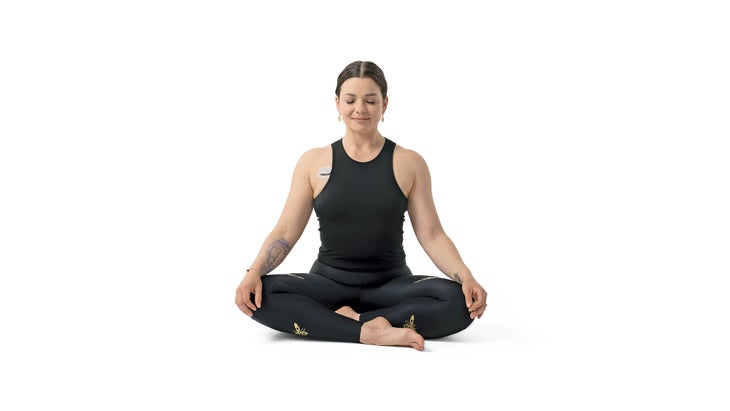
Connect to your spine and your breath. Chant silently on both your inhalations and exhalations:
Om
Om
Om Namaha
Om Namaha
Om Namo Namaha
Om Namo Namaha
Om Namo Namo Namaha
Om Namo Namo Namaha
Om Namo Namaha
Om Namo Namaha
Om Namaha
Om Namaha
Om
Om
MEDITATION
Rest, sitting in silence.
See also Self-Inquiry Meditation
Chant and Meditation

Connect to your spine and your breath. Chant silently on both your inhalations and exhalations:
Om
Om
Om Namaha
Om Namaha
Om Namo Namaha
Om Namo Namaha
Om Namo Namo Namaha
Om Namo Namo Namaha
Om Namo Namaha
Om Namo Namaha
Om Namaha
Om Namaha
Om
Om
MEDITATION
Rest, sitting in silence.
See also Self-Inquiry Meditation
Virabhadrasana I (Warrior Pose l)
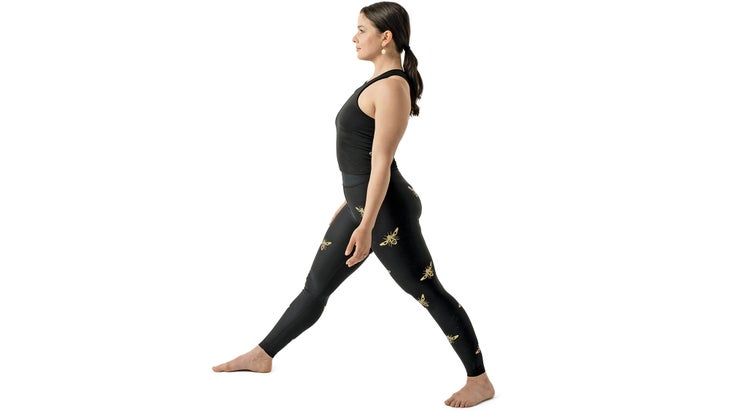
A Stand with one foot forward, your feet as wide as your hips and your arms at your sides.
See also Warrior I Pose
Virabhadrasana I (Warrior Pose l)
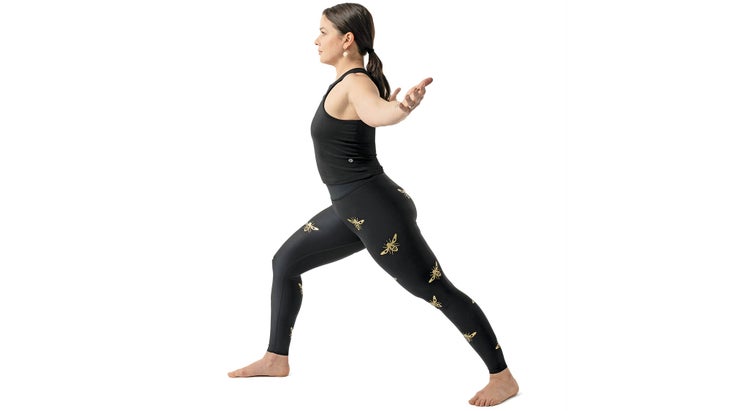
B Inhale, bend your front knee, displacing your chest slightly ahead of your pelvis as you arch your back. Sweep your arms out and up, and silently recite the first line of the chant (right).
See also 5 Experts, 1 Pose: Find New Nuances to Warrior I
Virabhadrasana I (Warrior Pose l)
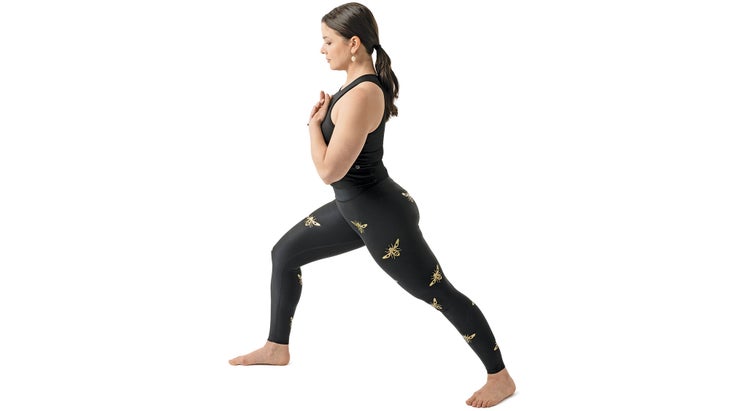
C Exhale, move your hands toward the top of your head, across your face, then to your heart, while chanting the same line aloud. Repeat 4 times total; with each repetition, chant the subsequent line. (Follow this pattern for poses 8-11.) Switch sides.
CHANT
Om
Om Namaha
Om Namo Namaha
Om Namo Namo Namaha
See also Watch + Learn: Warrior I Pose
Utkatasana, Chair Pose Variation
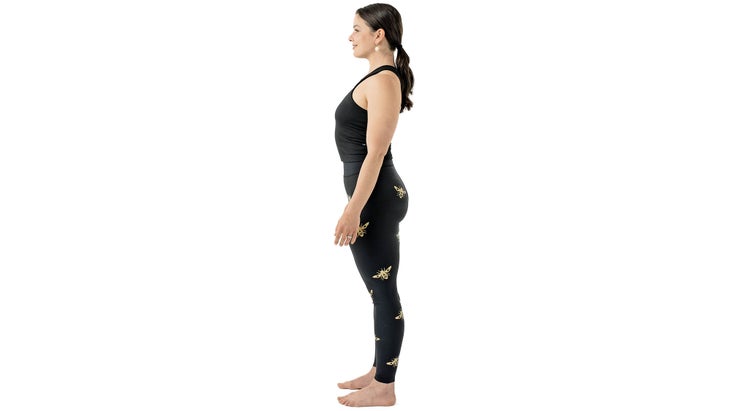
E Exhale, lowering your arms, chanting aloud. Repeat 4 times.
See also Standing Yoga Poses
Utkatasana, Chair Pose Variation
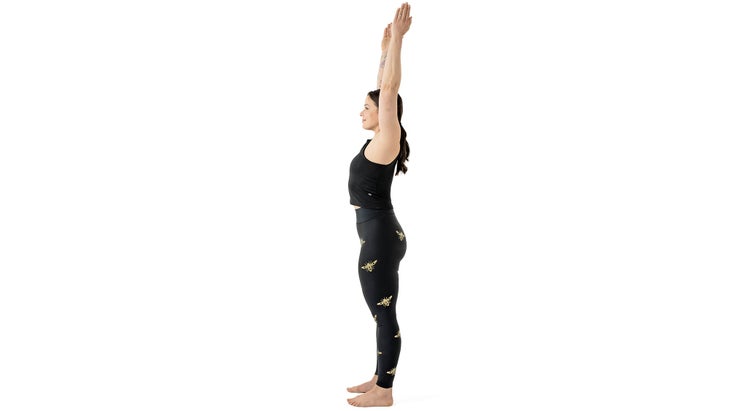
D Inhale your arms up to standing. Chant silently.
Utkatasana, Chair Pose Variation
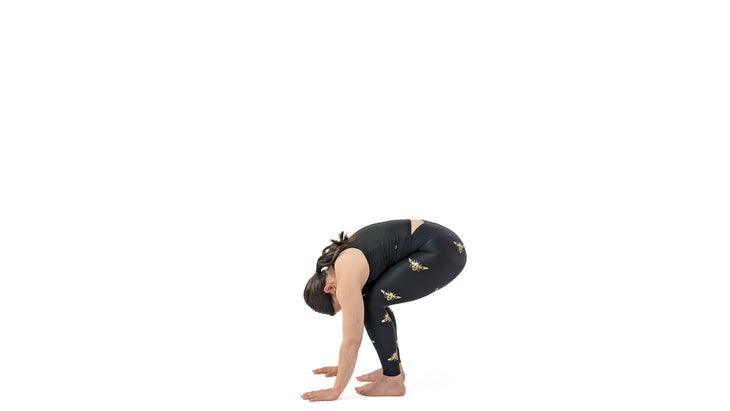
C Exhale and fold forward, bending your knees and bringing your chest to your thighs and your palms to the sides of your feet. Chant aloud.
See also Chair Pose
Utkatasana, Chair Pose Variation

D Inhale your arms up to standing. Chant silently.
Utkatasana, Chair Pose Variation

E Exhale, lowering your arms, chanting aloud. Repeat 4 times.
See also Standing Yoga Poses
Urdhva Mukha Svanasana, Upward-Facing Dog Pose variation
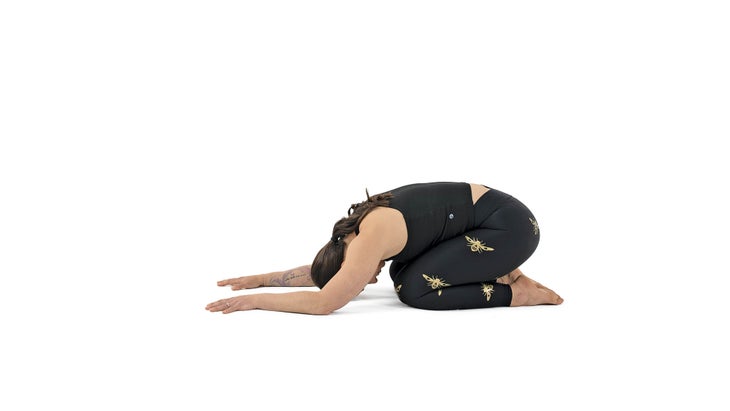
C Exhale back to Child’s Pose, chanting aloud. Repeat 4 times.
Urdhva Mukha Svanasana, Upward-Facing Dog Pose variation
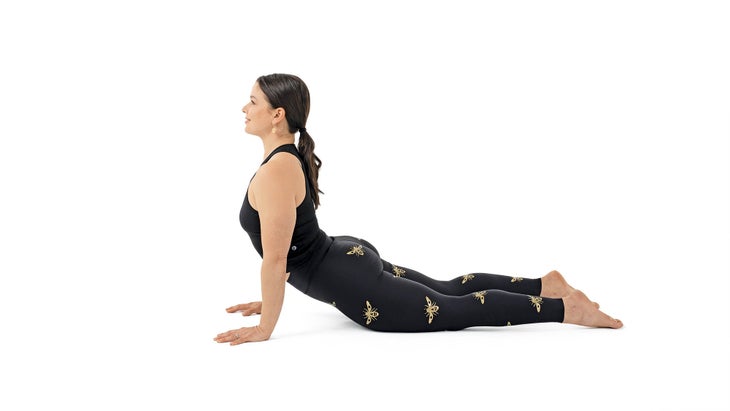
B Inhale to Upward-Facing Dog, keeping your knees on the floor. Silently chant:
Om
Om Namaha
Om Namo Namaha
Om Namo Namo Namaha
See also Upward-Facing Dog Pose
Urdhva Mukha Svanasana, Upward-Facing Dog Pose variation

C Exhale back to Child’s Pose, chanting aloud. Repeat 4 times.
Sukhasana Parivrtti (Seated Twist)
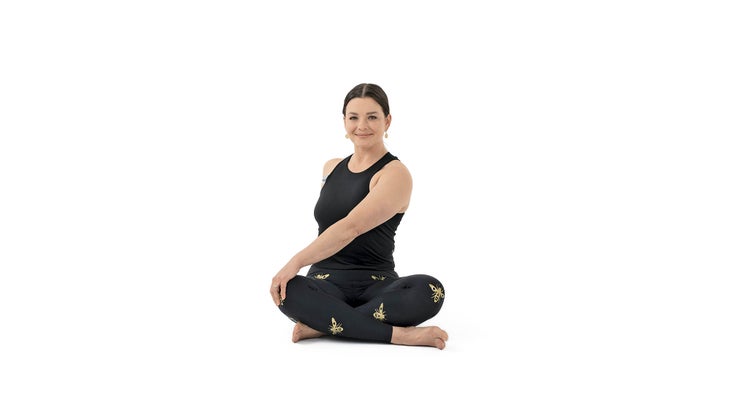
In a seated position, bring your left hand to your right knee, and your right hand to rest behind you. Inhale to lengthen, silently chanting:
Om
Om Namaha
Om Namo Namaha
Om Namo Namo Namaha
Exhale to twist your torso, looking over your right shoulder and chanting aloud. Repeat 4 times, twisting a bit farther on each exhalation. Then switch sides.
See also Twist Yoga Poses
Cakravakasana, Ruddy Goose Pose
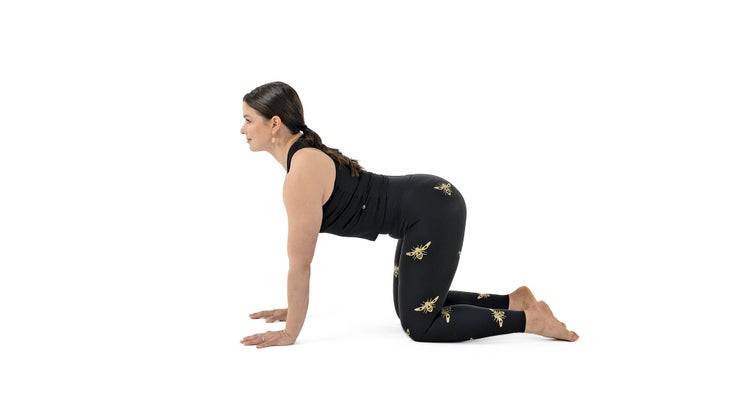
C Inhale back to Tabletop. Repeat 4 times total.
Cakravakasana, Ruddy Goose Pose
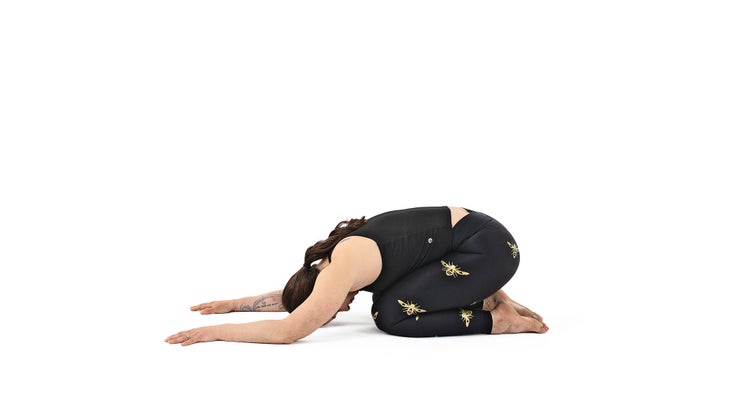
B Exhale into Child’s Pose, flexing your elbows as you bring your head to the floor.
See also A Healing Yoga Sequence to Ease Neck + Shoulder Pain
Cakravakasana, Ruddy Goose Pose

C Inhale back to Tabletop. Repeat 4 times total.
Chant and Meditation

Connect to your spine and your breath. Chant silently on both your inhalations and exhalations:
Om
Om
Om Namaha
Om Namaha
Om Namo Namaha
Om Namo Namaha
Om Namo Namo Namaha
Om Namo Namo Namaha
Om Namo Namaha
Om Namo Namaha
Om Namaha
Om Namaha
Om
Om
MEDITATION
Rest, sitting in silence.
See also Self-Inquiry Meditation
Chant and Meditation

Connect to your spine and your breath. Chant silently on both your inhalations and exhalations:
Om
Om
Om Namaha
Om Namaha
Om Namo Namaha
Om Namo Namaha
Om Namo Namo Namaha
Om Namo Namo Namaha
Om Namo Namaha
Om Namo Namaha
Om Namaha
Om Namaha
Om
Om
MEDITATION
Rest, sitting in silence.
See also Self-Inquiry Meditation
Chant and Meditation

Connect to your spine and your breath. Chant silently on both your inhalations and exhalations:
Om
Om
Om Namaha
Om Namaha
Om Namo Namaha
Om Namo Namaha
Om Namo Namo Namaha
Om Namo Namo Namaha
Om Namo Namaha
Om Namo Namaha
Om Namaha
Om Namaha
Om
Om
MEDITATION
Rest, sitting in silence.
See also Self-Inquiry Meditation
About our author
Yoga therapist Gary Kraftsow evolved this approach to yoga from the teachings transmitted by T. Krishnamacharya and T.K.V. Desikachar of Madras, India. Gary is the director and senior teacher of the American Viniyoga Institute; the author of two books: Yoga for Wellness and Yoga for Transformation, four DVDs, and several online workshops, including Pranayama Unlocked, Meditation Unlocked, Yoga Therapy for Depression, Yoga Therapy for Better Sleep, Yoga Therapy for Anxiety, and Asana Unlocked. Learn more at viniyoga.com.
About our Model
Model Evan Soroka is a Viniyoga therapist in Aspen, Colorado. Learn more at evansoroka.com.